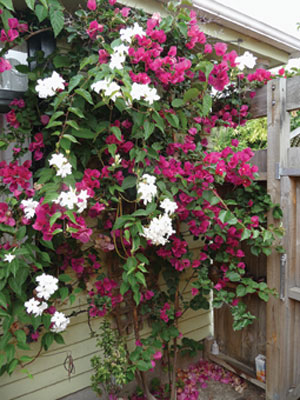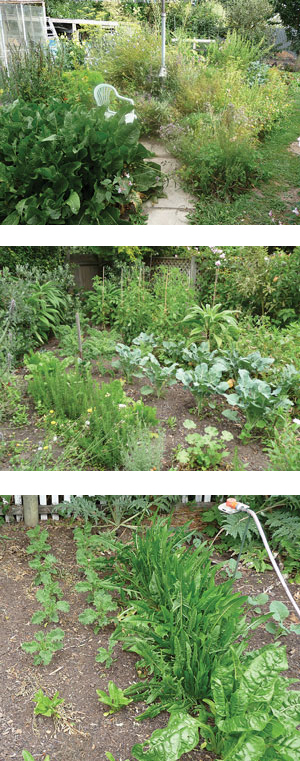Hei Mahi MāraAn attitude of gratitude
Apr 7, 2013

A beginner’s guide to growing organic vegetables
nā Tremane Barr
Recent research by the University of Otago found that eating more fruit and vegetables may make young people calmer, happier and more energetic in their daily life. This is a great start in understanding the link between nutrition and moods, and hopefully, ultimately health.
Photographs Tremane Barr

Bouganvillea and honeysuckle.
Time seems to have taken on a new meaning here in Christchurch, with everything measured in relation to September 4, 2010, and February 22 and June 13, 2011. This autumn season provides me with an opportunity to take time to be grateful for all the good things that have happened over the previous two-and-a-half years.
Even though these have been trying times, we are finally starting to see the first real signs of our community slowly rebuilding. This summer’s hot weather would have been disastrous with last summer’s limited water supply, but thanks to the hard work of council employees, the new water reticulation system has been a real blessing. Clean fresh water is the fundamental basis for all life, let alone a garden.
Every disaster is an opportunity for new things to be learnt and a new life, and so it is with the demolition of our old family home, and the rebuild of a new one due to start sometime in June. We have spent many hours discussing what we want from our quarter-acre section, because in our enthusiasm and somewhat more youthful years, we managed to turn our section into a monster with trees, climbers, roses and all other manner of interesting plants we found on special at garden centres.

From top: herb garden under washing line; broccoli replacing carrots as they are harvested; spinach, kale and chicory; right: the front garden.
The new plan is focused on making the section as easy-care as possible by removing many of the larger plants, trees and garden beds. Some of the new space will be taken up by the house and garage as they will be larger than before, which means that the front veggie garden and flower beds will no longer exist. The remaining open spaces will be turned into grass or low-maintenance native shrub such as hebes (and, yes, a space or two for my wife’s beloved roses, flowers and bougainvilleas). This will provide a grassed space for our mokopuna to (eventually) play and a more, easy-going lifestyle for us in the future, while keeping the most productive vegetable garden at the back of the section.
Back in the tunnel house, my experiment using new acid-free tomato varieties this season hasn’t worked very well, providing a low yield and lots of complaints from the whānau about the lack of tomatoes. I suspect that this is partly to do with me not having the time to regularly spray a liquid fertiliser. Next year I will go back to the good old Moneymaker variety. However, the outdoor tomato heirloom varieties have done well overall, and at this time of year I sow a cover crop of lupins under them before we are finished harvesting from them. We will be freezing any excess tomatoes to use through the winter months as our freezer is now devoid of all our usual organic beef and lamb, due to the new cancer-beating diet we are on.
Early autumn is a good time to sow or plant seedlings for late winter and early spring production. These include broad beans, cabbage, broccoli, cauliflower, kale, cavolo nero, leeks, winter lettuce, silver beet and spinach. The need to supply myself with a high volume of green juicing vegetables such as spinach, kale, silver beet, broccoli and parsley will be the focus of this season’s gardening efforts. I would like to include carrots on the list, but I haven’t yet found a way to organically deal with carrot fly so I avoid late summer and autumn crops of carrots. Given the soil test I mentioned in my previous article, I will only use a minimal amount of organic fertiliser/compost in the direct area where I plant new seedlings.
I found that parsley grew really well in the tunnel house last winter so will be planting that for this winter’s harvest, along with some spinach instead of just the usual lettuces. The need for increasing production of greens for juicing and meals means that I will be digging out my old cloches to plant out more silver beet and broccoli in late autumn, which should be able to cover any gap in production in the early spring.
Recent research by the University of Otago found that eating more fruit and vegetables may make young people calmer, happier and more energetic in their daily life. This is a great start in understanding the link between nutrition and moods, and hopefully, ultimately health.
I can only state from my personal experience that significantly increasing my vegetable and fruit intake has been beneficial for my state of mind and physical health. Both have only got better since I was diagnosed with cancer in mid-2012. It truly is a great time to be alive.
University of Otago nutrition and mood study
http://www.otago.ac.nz/